Community-Based Watershed Change: A Case Study in Eastern Congo
Abstract
1. Introduction
2. Materials and Methods
3. Results
- Increased cooperation within and between communities;
- Removal of trade barriers—specifically illegal roadblocks and tolls—between communities;
- A decrease in local court cases;
- Community leaders successfully discouraging youth from joining armed groups.
4. Discussion
- Savings groups were established and became stronger over the study period;
- Groups were a catalyst for tree planting, more sustainable farming, and contributed to less burning;
- Group/community action resulted in improved ecosystem health in the treatment watershed as evidenced by more trees, improved community forest management, and healthier farms.
5. Conclusions
Author Contributions
Funding
Acknowledgments
Conflicts of Interest
Abbreviations
| DID | Difference in differences |
| DRC | Democratic Republic of the Congo |
| EMI | Ebenezer Ministries International |
| hh | household |
| MODIS | Moderate resolution imaging spectroradiometer |
| NDVI | Normalized difference vegetation index |
| RCT | Randomized control trial |
| Sq km | square kilometres |
| TOC | Theory of change |
| VSLA | Village Savings and Loans Associations |
Appendix A
- savings habit: frequency of households who are actively saving cash
- savings amount per hh: mean number of months that households estimate they have in emergency reserves
- cell phone ownership: frequency of households owning a cell phone
- rooms per hh: mean number of room in households
- hh with girls in secondary school: frequency of girls regularly attending secondary school (at least 10 day per month)
- income diversity: mean count of income sources per household
- crop diversity: mean count of crops harvested in the past 12 months per household
- percent of land protected per hh: mean percentage of land per farm protected with trees or soil conservation measures
- soil quality: mean farmer perception of soil quality on their farm, scale of 1–5
- sustainable farming technique diversity: mean count of sustainable farming techniques applied per household
- meals per day: mean number of meals per day per household
- nutrition diversity: mean index score based on frequency of consuming 5 food categories per household
- trees planted per hh/year: mean number of trees planted in the past 12 months per household
- hh planting native tree species: frequency of households planting native tree species
- hh donating to local church/mosque: frequency of households donating cash to a church or mosque
- Incidence of dirt floor in household: frequency of households having dirt floors
- hh owning land: frequency of households owning land
- hh reducing meal portions in past 30 days: frequency of households who reduced meal portions in the past 30 days
- average time to and from drinking water: mean amount of time to travel to and from nearest drinking water source per household
- hh selling crops: frequency of households who sold crops in past 12 months
- Amount of land owned per hh: mean amount of land owned per household
Appendix B
- Watershed Map:
- workshop participants were provided with a base satellite image of their local watershed, and asked to identify areas of increasing tree cover, decreasing tree cover, as well as important water sources
- Change Matrix:
- workshop participants identified important changes in the watershed in the most recent 3 year period; changes were weighted, and the top two changes were discussed in more detail according causes, consequences, and lessons learned
- Worldview Analysis:
- workshop participants identified key challenges facing the watershed. Priority challenges were selected through weighting, and then the 10 seed technique was used to analyze priority challenges according to level of community responsibility/influence
- Peace and Reconciliation Analysis:
- workshop participants shared accounts of peace and reconciliation in the watershed in the most recent 2 year period. Cases were selected from among all shared accounts and these were analysed in depth by the group
References
- Butsic, V.; Baumann, M.; Shortland, A.; Walker, S.; Kuemmerle, T. Conservation and conflict in the Democratic Republic of Congo: The impacts of warfare, mining, and protected areas on deforestation. Biol. Conserv. 2015, 191, 266–273. [Google Scholar] [CrossRef]
- Nackoney, J.; Molinario, G.; Potapov, P.; Turubanova, S.; Hansen, M.C.; Furuichi, T. Impacts of civil conflict on primary forest habitat in northern Democratic Republic of the Congo, 1990–2010. Biol. Conserv. 2014, 170, 321–328. [Google Scholar] [CrossRef]
- Potapov, P.V.; Turubanova, S.A.; Hansen, M.C.; Adusei, B.; Broich, M.; Altstatt, A.; Mane, L.; Justice, C.O. Quantifying forest cover loss in Democratic Republic of the Congo, 2000–2010, with Landsat ETM+ data. Remote Sens. Environ. 2012, 122, 106–116. [Google Scholar] [CrossRef]
- Unruh, J.; Bailey, J. Management of spatially extensive natural resources in postwar contexts: Working with the peace process. GeoJournal 2009, 74, 159–173. [Google Scholar] [CrossRef]
- Nielsen, M.R.; Pouliot, M.; Kim Bakkegaard, R. Combining income and assets measures to include the transitory nature of poverty in assessments of forest dependence: Evidence from the Democratic Republic of Congo. Ecol. Econ. 2012, 78, 37–46. [Google Scholar] [CrossRef]
- Gaynor, K.M.; Fiorella, K.J.; Gregory, G.H.; Kurz, D.J.; Seto, K.L.; Withey, L.S.; Brashares, J.S. War and wildlife: Linking armed conflict to conservation. Front. Ecol. Environ. 2016, 14, 533–542. [Google Scholar] [CrossRef]
- Kanyamibwa, S. Impact of war on conservation: Rwandan environment and wildlife in agony. Biodivers. Conserv. 1998, 7, 1399–1406. [Google Scholar] [CrossRef]
- Beyers, R.L.; Hart, J.A.; Sinclair, A.R.E.; Grossmann, F.; Klinkenberg, B.; Dino, S. Resource wars and conflict ivory: The impact of civil conflict on elephants in the Democratic Republic of Congo—The case of the Okapi Reserve. PLoS ONE 2011, 6, e27129. [Google Scholar] [CrossRef]
- Busch, J.; Ferretti-Gallon, K. What Drives Deforestation and What Stops It? A Meta-Analysis. Rev. Environ. Econ. Policy 2017, 11, 3–23. [Google Scholar] [CrossRef]
- Adams, W.M.; Aveling, R.; Brockington, D.; Dickson, B.; Elliott, J.; Hutton, J.; Roe, D.; Vira, B.; Wolmer, W. Biodiversity Conservation and the Eradication of Poverty. Science 2004, 306, 1146–1149. [Google Scholar] [CrossRef]
- Berkes, F. Rethinking Community-Based Conservation. Conserv. Biol. 2004, 18, 621–630. [Google Scholar] [CrossRef]
- Terborgh, J.; Peres, C.A. Do Community-Managed Forests Work? A Biodiversity Perspective. Land 2017, 6, 22. [Google Scholar] [CrossRef]
- Oldekop, J.A.; Holmes, G.; Harris, W.E.; Evans, K.L. A global assessment of the social and conservation outcomes of protected areas. Conserv. Biol. 2016, 30, 133–141. [Google Scholar] [CrossRef] [PubMed]
- Bowler, D.E.; Buyung-Ali, L.M.; Healey, J.R.; Jones, J.P.G.; Knight, T.; Pullin, A.S. Does community forest management provide global environmental benefits and improve local welfare? Does community forest management provide global environmental benefits and improve local welfare? Front. Ecol. Environ. 2012, 10, 29–36. [Google Scholar] [CrossRef]
- Gilmour, D.A. Forty Years of Community-Based Forestry: A Review of Its Extent And Effectiveness; FAO: Rome, Italy, 2016; ISBN 978-92-5-109095-4. [Google Scholar]
- Mehlman, P.T. Current Status of Wild Gorilla Populations and Strategies for Their Conservation. In Conservation in the 21st Century: Gorillas as a Case Study; Stoinski, T.S., Steklis, H.D., Mehlman, P.T., Eds.; Developments in Primatology: Progress and Prospects; Springer US: Boston, MA, USA, 2008; pp. 3–54. ISBN 978-0-387-70721-1. [Google Scholar]
- Bele, M.Y.; Sonwa, D.J.; Tiani, A.-M. Adapting the Congo Basin forests management to climate change: Linkages among biodiversity, forest loss, and human well-being. For. Policy Econ. 2015, 50, 1–10. [Google Scholar] [CrossRef]
- Kaiser, E.T.; Thongdi, B.; Pawkham, J.; Satre, D.; Watt, J.; Morikawa, R. Healthy Forest, Healthy People II: Remote Sensing and Community Networks Extend the Benefits of Community Forestry in Thailand. In Proceedings of the 2018 IEEE Global Humanitarian Technology Conference (GHTC), San Jose, CA, USA, 18–21 October 2018; pp. 1–6. [Google Scholar]
- Kaiser, E.T.; Roberts, K.; Pawkham, J.; Thongdi, B.; Morikawa, R.; Satre, D. Healthy Forest, Healthy People: Remote Sensing and Monitoring Support Implementation of Community Forestry in Thailand. In Proceedings of the 2012 IEEE Global Humanitarian Technology Conference, Seattle, WA, USA, 21–24 October 2012; pp. 111–116. [Google Scholar]
- Royer, S.D.; Noordwijk, M.V.; Roshetko, J.M. Does Community-Based Forest Management in Indonesia Devolve Social Justice or Social Costs? Int. For. Rev. 2018, 20, 167–180. [Google Scholar] [CrossRef]
- Somanathan, E.; Prabhakar, R.; Mehta, B.S. Decentralization for cost-effective conservation. Proc. Natl. Acad. Sci. USA 2009, 106, 4143–4147. [Google Scholar] [CrossRef] [PubMed]
- Blomley, T.; Pfliegner, K.; Isango, J.; Zahabu, E.; Ahrends, A.; Burgess, N. Seeing the wood for the trees: An assessment of the impact of participatory forest management on forest condition in Tanzania. Oryx 2008, 42, 380–391. [Google Scholar] [CrossRef]
- Seymour, F.S. Evidence Linking Community-Level Tenure and Forest Condition: An Annotated Bibliography; Climate and Land Use Alliance: San Francisco, CA, USA, 2014. [Google Scholar]
- Rechlin, M.A.; Burch, W.R.; Hammett, A.L.; Subedi, B.; Binayee, S.; Sapkota, I. Lal Salam and Hario Ban: The Effects of the Maoist Insurgency on Community Forestry in Nepal. For. Trees Livelihoods 2007, 17, 245–253. [Google Scholar] [CrossRef]
- Nightingale, A.; Sharma, J.R. Conflict resilience among community forestry user groups: Experiences in Nepal. Disasters 2014, 38, 517–539. [Google Scholar] [CrossRef]
- Altieri, M.A.; Nicholls, C.I.; Henao, A.; Lana, M.A. Agroecology and the design of climate change-resilient farming systems. Agron. Sustain. Dev. 2015, 35, 869–890. [Google Scholar] [CrossRef]
- Pretty, J.; Toulmin, C.; Williams, S. Sustainable intensification in African agriculture. Int. J. Agric. Sustain. 2011, 9, 5–24. [Google Scholar] [CrossRef]
- Pretty, J.N.; Morison, J.I.L.; Hine, R.E. Reducing food poverty by increasing agricultural sustainability in developing countries. Agric. Ecosyst. Environ. 2003, 95, 217–234. [Google Scholar] [CrossRef]
- Chisenga, C. Socio-Economic Factors Associated with the Adoption of Conservation Agriculture among Women Farmers in Balaka District, Malawi. Master’s Thesis, Purdue University, West Lafayette, IN, USA, 2015. [Google Scholar]
- Lalani, B.; Dorward, P.; Holloway, G.; Wauters, E. Smallholder farmers’ motivations for using Conservation Agriculture and the roles of yield, labour and soil fertility in decision making. Agric. Syst. 2016, 146, 80–90. [Google Scholar] [CrossRef]
- Pratt, O.J.; Wingenbach, G. Factors affecting adoption of green manure and cover crop technologies among Paraguayan smallholder farmers. Agroecol. Sustain. Food Syst. 2016, 40, 1043–1057. [Google Scholar] [CrossRef]
- VSL Associates. Available online: http://www.vsla.net/programmetool/projectplanning;jsessionid=1scrwbjmp5z991cnapff1r54w2 (accessed on 15 March 2019).
- Karlan, D.; Ratan, A.L.; Zinman, J. Savings by and for the Poor: A Research Review and Agenda. Rev. Income Wealth 2014, 60, 36–78. [Google Scholar] [CrossRef] [PubMed]
- Anyango, E.; Esipisu, E.; Opoku, L.; Johnson, S.; Malkamaki, M.; Musoke, C. Village Savings and Loan Associations: Experience from Zanzibar. Small Enterp. Dev. 2007, 18, 11–24. [Google Scholar] [CrossRef]
- Steinert, J.I.; Zenker, J.; Filipiak, U.; Movsisyan, A.; Cluver, L.D.; Shenderovich, Y. Do saving promotion interventions increase household savings, consumption, and investments in Sub-Saharan Africa? A systematic review and meta-analysis. World Dev. 2018, 104, 238–256. [Google Scholar] [CrossRef]
- Karlan, D.; Savonitto, B.; Thuysbaert, B.; Udry, C. Impact of savings groups on the lives of the poor. Proc. Natl. Acad. Sci. USA 2017, 114, 3079–3084. [Google Scholar] [CrossRef]
- Beaman, L.; Karlan, D.; Thuysbaert, B. Saving for a (Not So) Rainy Day: A Randomized Evaluation of Savings Groups in Mali; National Bureau of Economic Research: Cambridge, MA, USA, 2014. [Google Scholar]
- Ksoll, C.; Lilleør, H.; Lønborg, J.; Rasmussen, O.D. Impact of Village Savings and Loan Associations: Evidence from a cluster randomized trial. J. Dev. Econ. 2016, 120, 70–85. [Google Scholar] [CrossRef]
- Kesanta, J.; Andre, B. Impact of Women Empowered through Community Savings Groups on the Wellbeing of their Families: A Study from Mgubwe, Tanzania. Interdiscip. J. Best Pract. Glob. Dev. 2015, 1, 15. [Google Scholar]
- Dees, M. Digging Deeper: The Quest for Conflict-Free Minerals. Master’s Thesis, Radboud University, Nijmegen, The Netherlands, 2018. [Google Scholar]
- Chevallier, R. Livelihood Interventions and Biodiversity Conservation in Quirimbas National Park. Available online: https://www.africaportal.org/publications/livelihood-interventions-and-biodiversityconservation-quirimbas-national-park/ (accessed on 15 March 2019).
- Shames, S.; Heiner, K.; Kapukha, M.; Kiguli, L.; Masiga, M.; Kalunda, P.N.; Ssempala, A.; Recha, J.; Wekesa, A. Building local institutional capacity to implement agricultural carbon projects: Participatory action research with Vi Agroforestry in Kenya and ECOTRUST in Uganda. Agric. Food Secur. 2016, 5, 13. [Google Scholar] [CrossRef]
- Morikawa, R. Remote Sensing Tools for Evaluating Poverty Alleviation Projects: A Case Study in Tanzania. Procedia Eng. 2014, 78, 178–187. [Google Scholar] [CrossRef][Green Version]
- Githunguri, C.; Njeru, P.; Kristjanson, P. CGIAR Research Program on Climate Change, Agriculture and Food Security (CCAFS); CCAFS Working Paper 90; CCAFS: Wageningen, The Netherlands, 2015; p. 112. [Google Scholar]
- Beukeboom, H.J.J.; VanderLaan, C.; VanKreveld, A.; Akwah, G. Can Community Forestry Contribute to Livelihood Improvement and Biodiversity? Steps on How to Improve Community Forestry Programmes, Lessons from Work in 11 Countries and Communities; World Wildlife Fund Technical Report: Driebergseweg, The Netherlands, 2010; p. 82. [Google Scholar]
- Buhaug, H. Climate-conflict research: Some reflections on the way forward. Wiley Interdiscip. Rev. Clim. Chang. 2015, 6, 269–275. [Google Scholar] [CrossRef]
- Weiss, C.H. Theory-based evaluation: Past, present, and future. New Dir. Eval. 1997, 1997, 41–55. [Google Scholar] [CrossRef]
- Sayer, J.A.; Margules, C.; Boedhihartono, A.K.; Sunderland, T.; Langston, J.D.; Reed, J.; Riggs, R.; Buck, L.E.; Campbell, B.M.; Kusters, K.; et al. Measuring the effectiveness of landscape approaches to conservation and development. Dev. Sustain. Sci. 2017, 12, 465–476. [Google Scholar] [CrossRef]
- ICF International. Spatial Data Repository, the Demographic and Health Surveys Program. Available online: http://spatialdata.dhsprogram.com/data/#/single/surveys/indicators/download (accessed on 20 March 2019).
- EMI Watershed Household Lists 2015. Available online: http://mauiguidebook.com/hikes/east-maui-irrigation-emi/ (accessed on 29 March 2019).
- DiMiceli, M.C. MOD44B MODIS/Terra Vegetation Continuous Fields Yearly L3 Global 250 m SIN Grid V006, 2017. U.S. Geological Survey. Available online: https://lpdaac.usgs.gov/products/mod44bv006/ (accessed on 29 March 2019).
- Doumenge, C. Forest Diversity, Distribution, and Dynamique in the Itombwe Mountains, South-Kivu, Congo Democratic Republic. Mt. Res. Dev. 1998, 18, 249–264. [Google Scholar] [CrossRef]
- Plant With Purpose—Environmental, Economic, and Spiritual Change. Available online: https://plantwithpurpose.org/ (accessed on 20 March 2019).
- Gertler, P.J.; Martinez, S.; Premand, P.; Rawlings, L.B.; Vermeersch, C.M.J. Impact Evaluation in Practice; The World Bank: Washington, DC, USA, 2010; ISBN 978-0-8213-8541-8. [Google Scholar]
- Didan, K. MOD13A3 MODIS/Terra vegetation Indices Monthly L3 Global 1km SIN Grid V006, 2015. U.S. Geological Survey. Available online: https://lpdaac.usgs.gov/products/mod13a3v006/ (accessed on 29 March 2019).
- ArcGIS Pro|ArcGIS Desktop. Available online: https://pro.arcgis.com/en/pro-app/ (accessed on 20 March 2019).
- Mayne, J. Contribution Analysis: An Approach to Exploring Cause and Effect; ILAC Brief: Montpellier, France, 2008. [Google Scholar]
- R: The R Project for Statistical Computing. Available online: https://www.r-project.org/ (accessed on 20 March 2019).
- Lawrence, M.J.; Stemberger, H.L.J.; Zolderdo, A.J.; Struthers, D.P.; Cooke, S.J. The effects of modern war and military activities on biodiversity and the environment. Environ. Rev. 2015, 23, 443–460. [Google Scholar] [CrossRef]
- Grey, E.; Peter, G.; Altamirano, J.; Ding, H.; Rozwalka, P.; Zuniga, I.; Witkin, M.; Borger, F.; Pereda, P.; Lucchesi, A.; et al. The Economic Costs and Benefits of Securing Community Forest Tenure—Evidence from Brazil and Guatemala; World Resources Institute: Washington, DC, USA, 2015. [Google Scholar]
- Inogwabini, B.-I. Conserving biodiversity in the Democratic Republic of Congo: A brief history, current trends and insights for the future. PARKS 2014, 20, 101–110. [Google Scholar] [CrossRef]
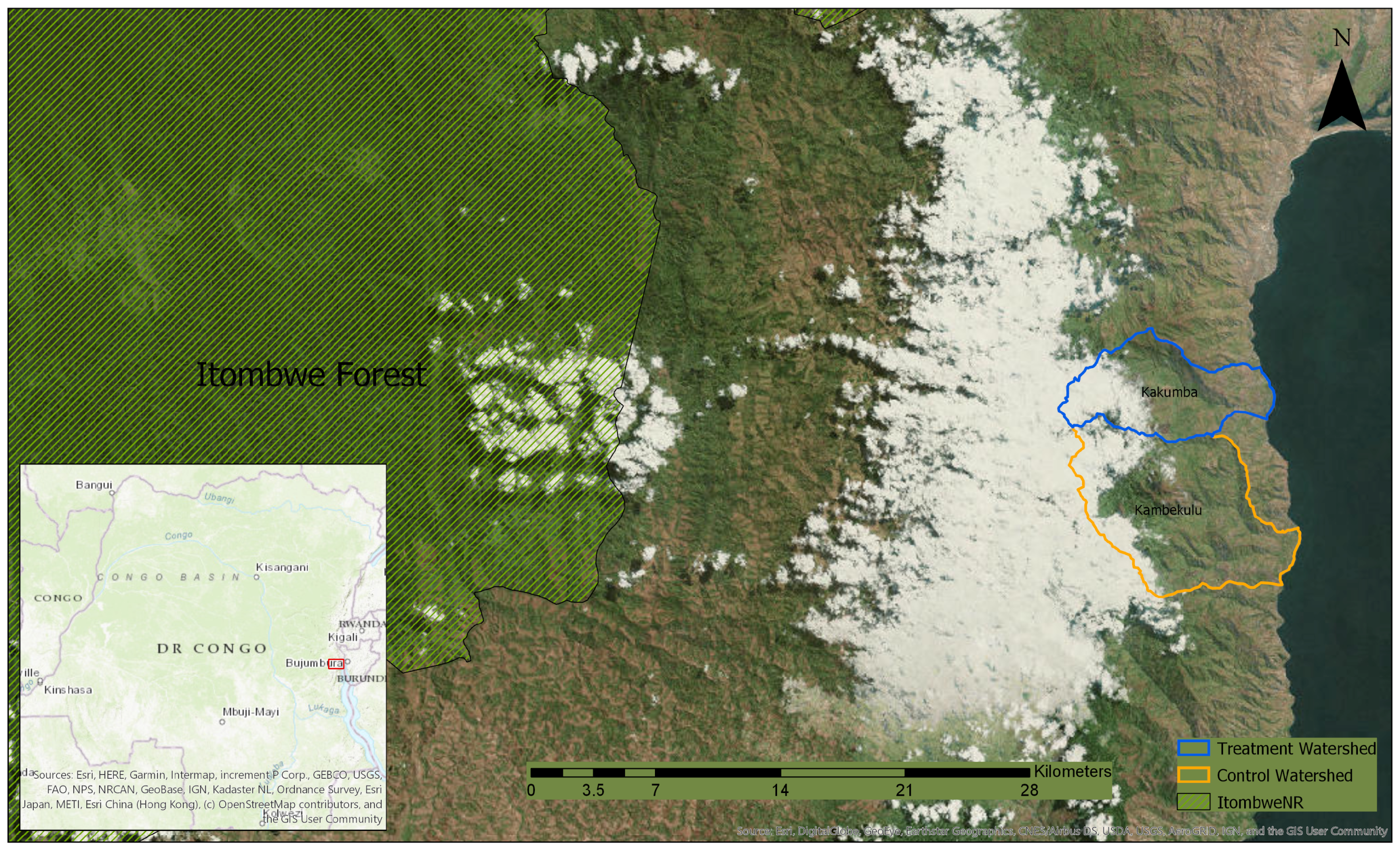

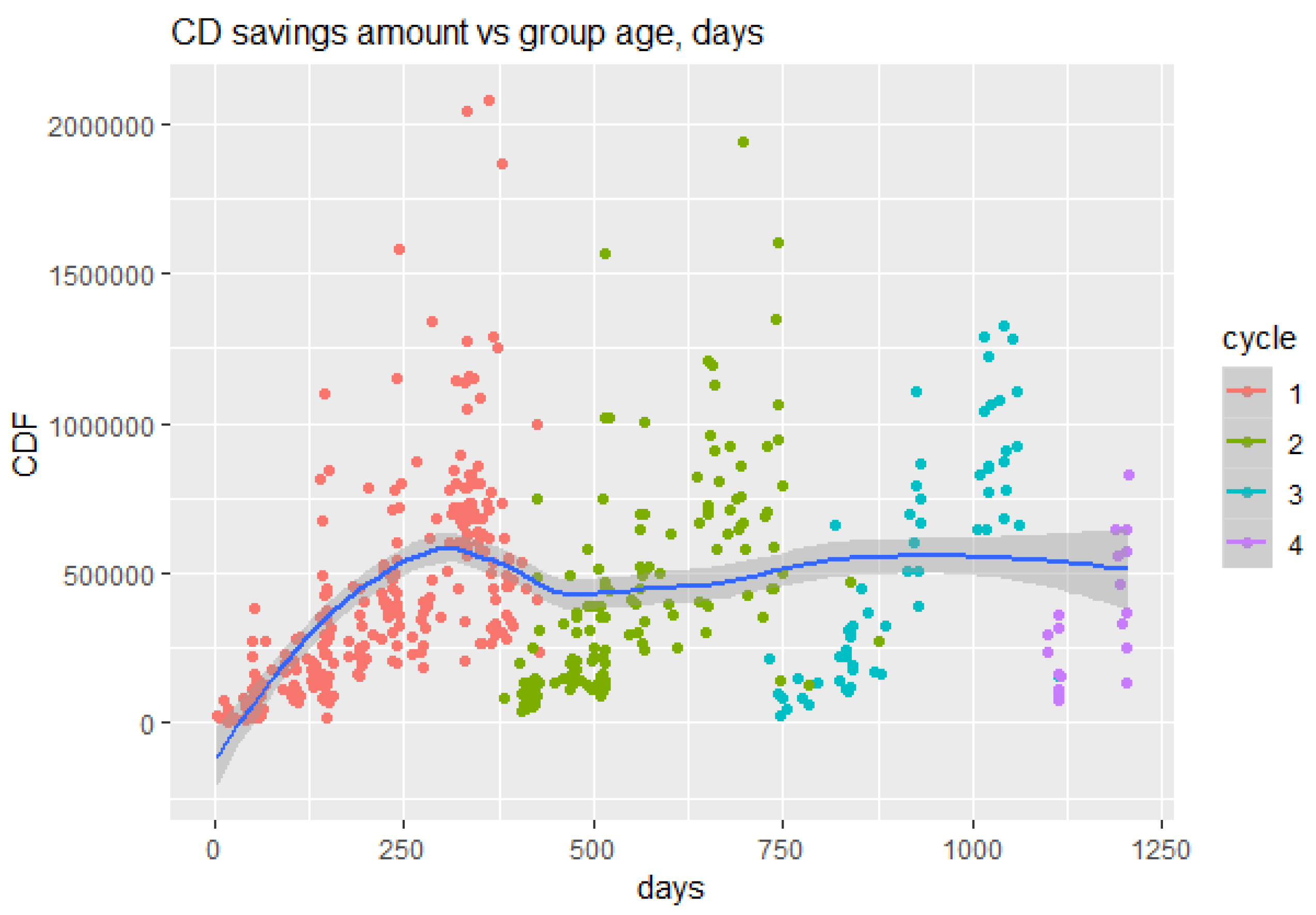
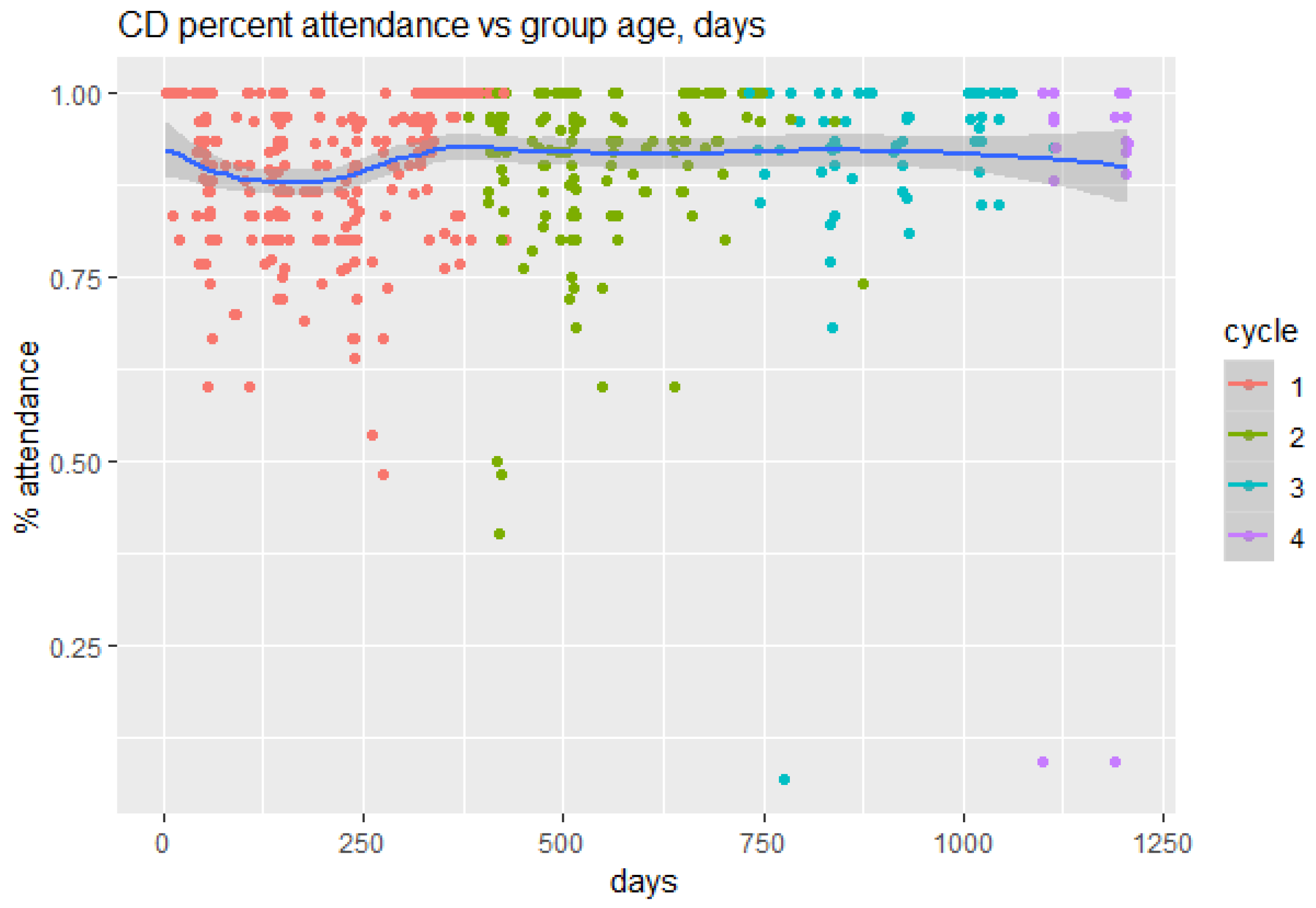
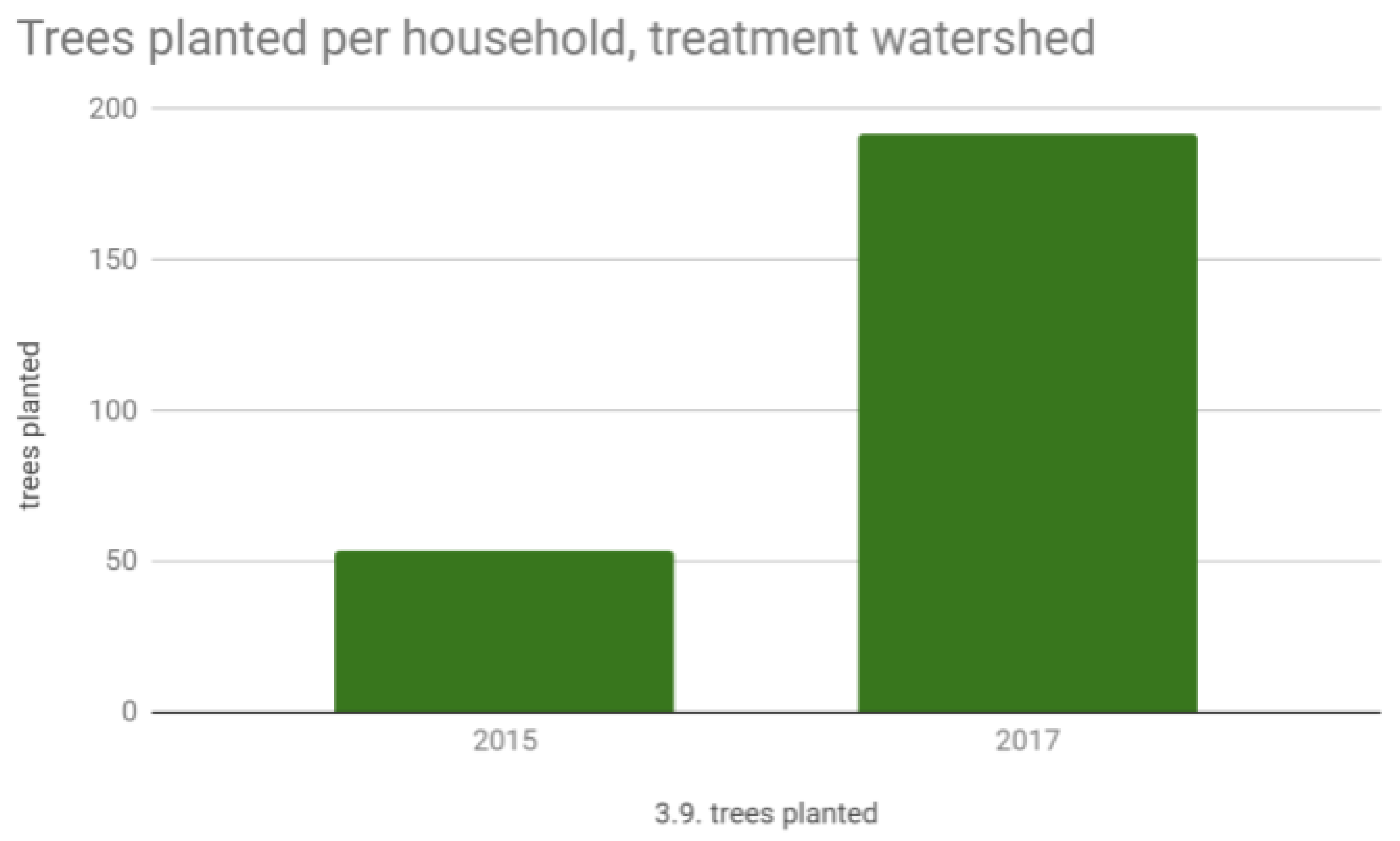
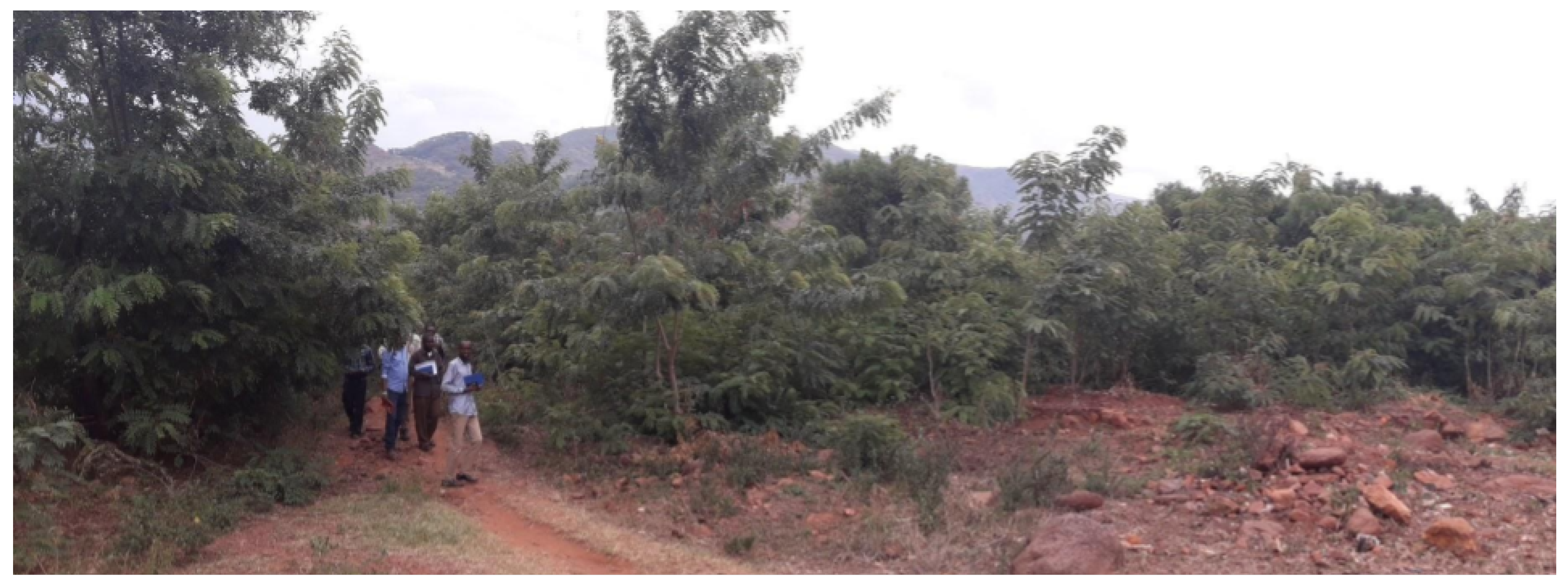
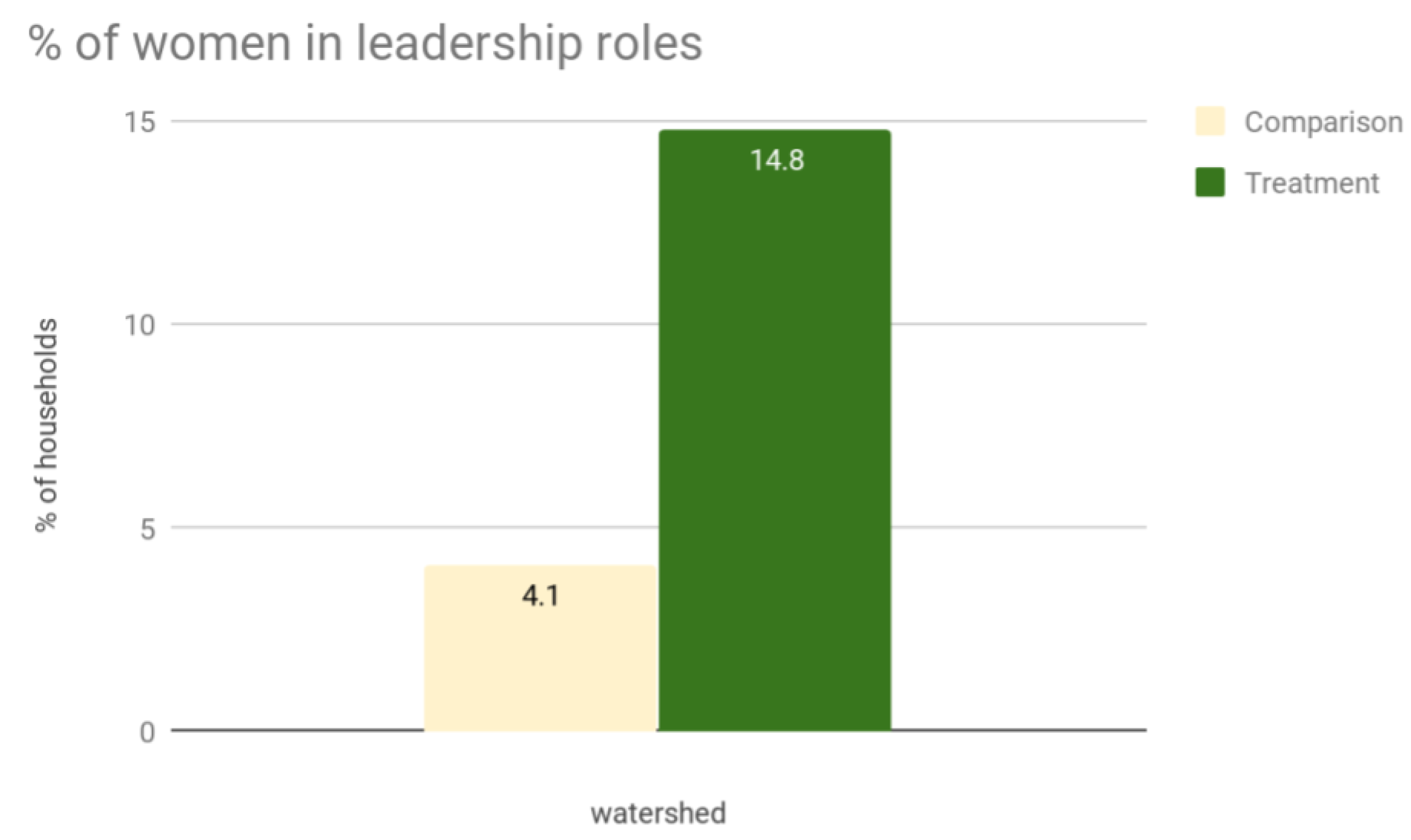
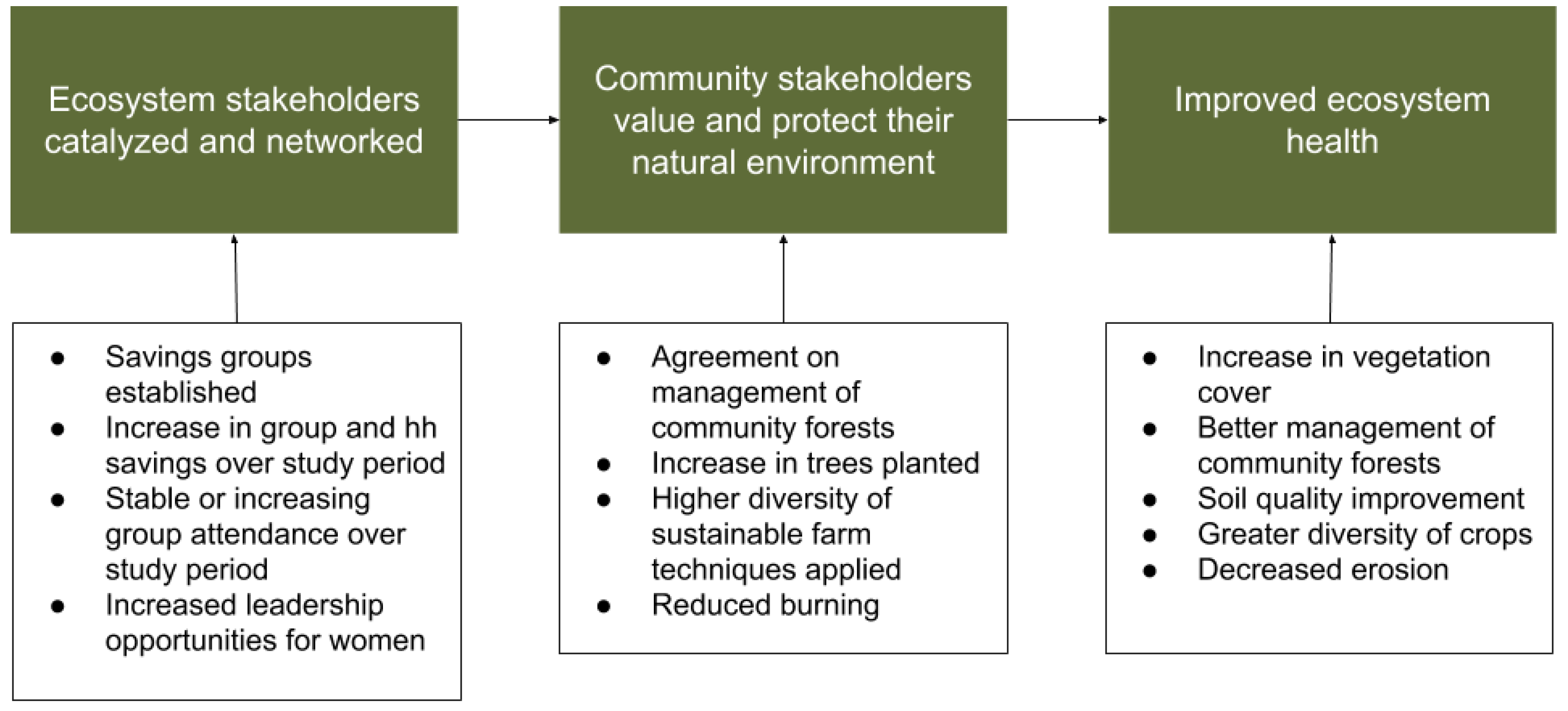
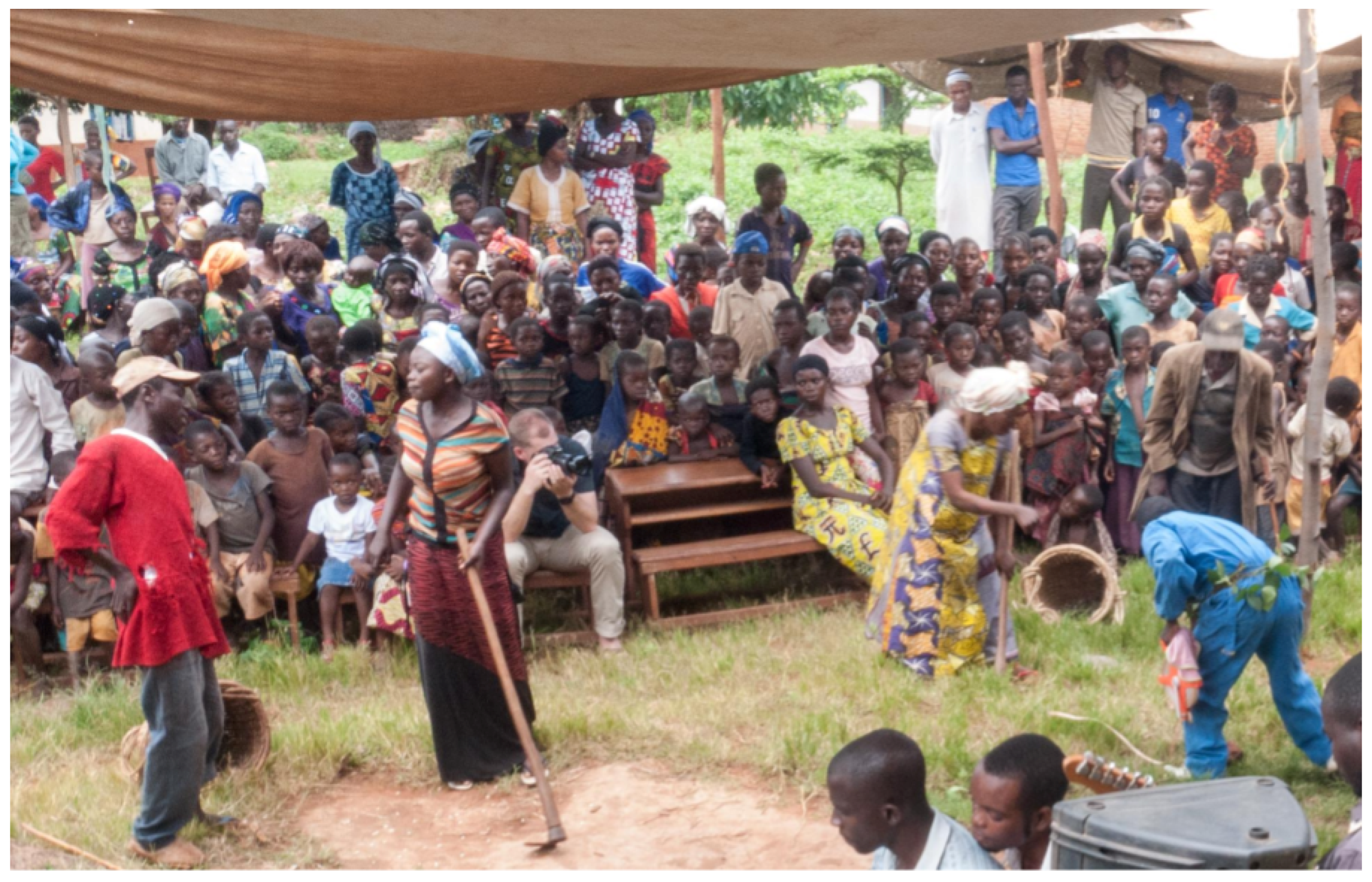
| Watershed | Area sq km | Population [50] | percent Tree cover 2010 [51] | Designation |
|---|---|---|---|---|
| Kakumba | 37 | 13,917 | 22.6% | treatment |
| Kambekulu | 54 | 16,338 | 27.5% | comparison |
| June 2017 | |
|---|---|
| VSLA groups | 21 |
| VSLA members | 609 |
| VSLA member equity (USD) | 11,160 |
| Trees planted | 165,000 |
| Indicator | Improvement | No Change | Decline | p-Value |
|---|---|---|---|---|
| Savings habit | X | 7.98 × 10 | ||
| Savings amount per household | X | 6.99 × 10 | ||
| Cell phone ownership | X | 1.01 × 10 | ||
| Rooms per household | X | 3.57 × 10 | ||
| Households with girls in secondary school | X | 0.00494 | ||
| Income diversity | X | 3.30 × 10 | ||
| Crop diversity | X | 9.67 × 10 | ||
| Percent of land protected per household | X | 1.36 × 10 | ||
| Soil quality | X | 2.00 × 10 | ||
| Sustainable farming technique diversity | X | 2.00 × 10 | ||
| Meals per day | X | 2.00 × 10 | ||
| Nutrition diversity | X | 1.08 × 10 | ||
| Trees planted per household/year | X | 3.44 × 10 | ||
| Households planting native tree species | X | 0.00827 | ||
| Households donating to local church/mosque | X | 0.000584 | ||
| Incidence of dirt floor in household | X | 0.992 | ||
| Households owning land | X | 0.1979 | ||
| Households reducing meal portions in past 30 days | X | 0.1842 | ||
| Average time to and from drinking water | X | 0.0724 | ||
| Households selling crops | X | 0.86889 | ||
| Amount of land owned per household | X | 0.01861 |
© 2019 by the authors. Licensee MDPI, Basel, Switzerland. This article is an open access article distributed under the terms and conditions of the Creative Commons Attribution (CC BY) license (http://creativecommons.org/licenses/by/4.0/).
Share and Cite
Sabin, S.; Dieudonne, B.; Mitchell, J.; White, J.; Chin, C.; Morikawa, R. Community-Based Watershed Change: A Case Study in Eastern Congo. Forests 2019, 10, 475. https://doi.org/10.3390/f10060475
Sabin S, Dieudonne B, Mitchell J, White J, Chin C, Morikawa R. Community-Based Watershed Change: A Case Study in Eastern Congo. Forests. 2019; 10(6):475. https://doi.org/10.3390/f10060475
Chicago/Turabian StyleSabin, Scott, Birori Dieudonne, John Mitchell, Jared White, Corey Chin, and Robert Morikawa. 2019. "Community-Based Watershed Change: A Case Study in Eastern Congo" Forests 10, no. 6: 475. https://doi.org/10.3390/f10060475
APA StyleSabin, S., Dieudonne, B., Mitchell, J., White, J., Chin, C., & Morikawa, R. (2019). Community-Based Watershed Change: A Case Study in Eastern Congo. Forests, 10(6), 475. https://doi.org/10.3390/f10060475




